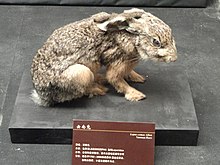Yunnan hare
| Yunnan hare | |
|---|---|

| |
| Scientific classification | |
| Domain: | Eukaryota |
| Kingdom: | Animalia |
| Phylum: | Chordata |
| Class: | Mammalia |
| Order: | Lagomorpha |
| Family: | Leporidae |
| Genus: | Lepus |
| Species: | L. comus
|
| Binomial name | |
| Lepus comus G. M. Allen, 1927
| |

| |
| Yunnan hare range | |
| Synonyms[2] | |
| |
| Yunnan hare | |
|---|---|
Hanyu Pinyin | Yúnnán tù |
The Yunnan hare (Lepus comus) is a medium-sized species of
Taxonomy
The Yunnan hare was first
- L. c. comus Allen, 1927
- L. c. peni Wang and Luo, 1985
- L. c. pygmaeus Wang and Feng, 1985
It was formerly considered a subspecies of the woolly hare (Lepus oiostolus), but is now treated as a separate species.[2][4] Cai and Feng (1982) and Wang (1985) elevated it to species status based on morphological and ecological differences from the woolly hare.[2] In 2005, it was found that molecular phylogenetics indicated the Yunnan hare and the woolly hare to be sister sister taxa,[1] and they may exhibit allopatric speciation or parapatric speciation.[2] It might also be related to the Indian hare (Lepus nigricollis) and probably be its northern form.[4]
Description
The Yunnan hare is a medium-sized hare, measuring 32.2 to 48 cm (12.7 to 18.9 in) in length, and weighing 1.8 to 2.5 kg (4.0 to 5.5 lb). It has a 9.5 to 11 cm (3.7 to 4.3 in) long light gray tail, tinged-yellow below, which is brownish on the upper surface. The skull is thin, measuring 8.4 to 9.5 cm (3.3 to 3.7 in) in length. It has soft, flat, and long dorsal pelage which is grayish brown or dark gray in color, and whitish ventral pelage—its back of the hip and rump are grayish, and ochraceous buff extending up to the forelegs, latus, and outer side of hindlegs. The short ears measure 9.7 to 13.5 cm (3.8 to 5.3 in) in length, are pale gray at the inner surface, and black at the top. A whitish band runs from the base of the ear to the snout, including an arch over the eye. It has short nasal cavities, broad at the back side. At normal unworn state, the upper incisors are Y-shaped, and become V-shaped when worn out. The hindfeet are 9.8 to 13 cm (3.9 to 5.1 in) long.[3]
L. c. comus is the largest subspecies. The total length of the skull is more than 8.8 centimetres (3.5 in), and the height of the cheek bone is less than 7 millimetres (0.28 in). The nose protrudes forward, and reaches up to the front of the upper incisor. L. c. pygmaeus is the smallest subspecies, with the narrowest frontal aspects and the longest latus.[5]
The Yunnan hare is smaller than the woolly hare; the supraorbitals are flat and small, and the toothrow and diastema (space between two teeth) are of different proportions. It also has a characteristic brighter pelage than the woolly hare, although, according to Gao Yaoting, the Yunnan hare's gray rump is also a characteristic of the woolly hare.[4]
Distribution and habitat
The species is found across the western
It is a mountainous species,[4] and prefers warm, wet habitat.[3] Although not much is known about its habitat, it is thought to occur in high montane shrubs and meadows throughout its distribution, similar to the Tibetan habitat of the woolly hare (Lepus oiostolus).[4] It may also occur in open forests or forest edges. It is found at medium elevations of 1,300 to 3,200 m (4,300 to 10,500 ft) above sea level.[3]
Behavior and ecology
The Yunnan hare is a diurnal species, but is also active during the night to forage.[1] It is an herbivore, and forages on shrubs and forbs.[7] According to reports by hunters, the adult Yunnan hare has three burrows; those of the male are shallower, smaller, and straighter than those of the female that are oval and larger in shape.[1] Breeding usually commences in April. There are one to four, usually two, young in a litter, and in May, the female gives two or three litters.[1][3]
Status and conservation
Since 1996, the Yunnan hare is rated as a species of
References
- ^ . Retrieved 15 November 2021.
- ^ OCLC 62265494.
- ^ ISBN 978-1-4008-3411-2.)
{{cite book}}: CS1 maint: multiple names: authors list (link - ^ ISBN 978-2-8317-0019-9.
- S2CID 12173659.
- ^ "Lepus comus (Yunnan Hare)". Global Species. Myers Enterprises II. Retrieved 8 September 2017.
- ISBN 978-1-4008-4688-7.

